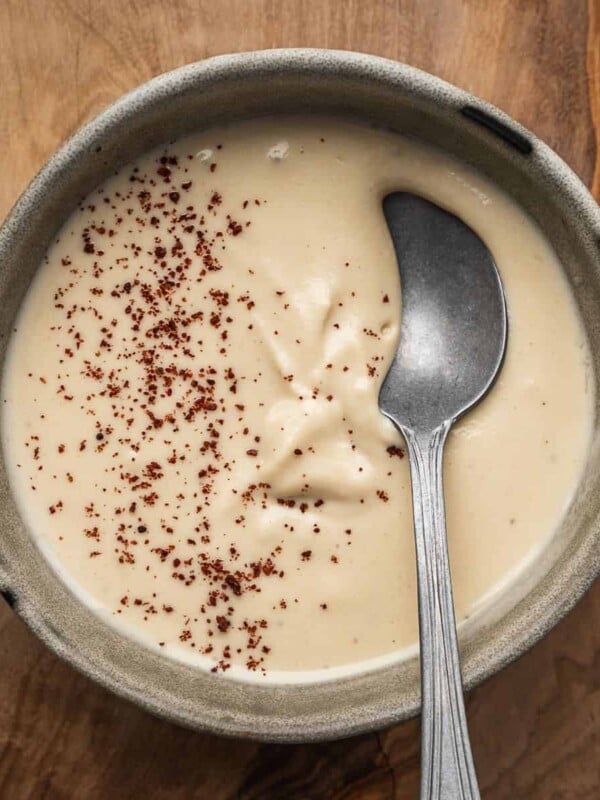Harissa Paste is one of those condiments you could easily pick up from the store, but why not make it yourself to suit your personal taste and preferences? This recipe is simple and straightforward, allowing you to control the heat and flavor profile. Use this homemade harissa as a vibrant marinade for chicken, fish, vegetables, or even tofu.
Try it in my Harissa Chicken Skewers or my Harissa Honey Chicken recipes and pair it with Vermicelli Rice, Sumac Onions and a refreshing chopped tomato and cucumber salad.

Table of Contents
What is Harissa?
Harissa paste is a spicy, aromatic North African red chili pepper paste. It’s made from a blend of dried and/or fresh red chilies, garlic, olive oil, and warm spices like cumin, coriander, and caraway seeds.
Some recipes (like mine) also include ingredients like tomatoes, bell peppers, or lemon juice for added depth and acidity.
It is known for its complex flavor profile (smoky, earthy, tangy, and spicy) and it’s used to add a kick to stews, soups, marinades, and dips. I personally like using it as a marinade in my Harissa Chicken Skewers recipe.
It’s a staple in North African and Middle Eastern cuisine and works well as a condiment or ingredient to spice up a variety of dishes, from roasted vegetables to grilled meats. This cuisine relies heavily on marinades (like Chermoula), condiments and spice blends.
If you’re curious, I encourage you to learn more about Sumac, Za’atar spice blend and Baharat (7-spice blend).
Ingredients
This recipe is very straightforward. Most of the ingredients are pantry staples, with a couple of exceptions. You should be able to find everything you need at your local Middle Eastern market or well stocked grocery store.

- Hot Peppers: This recipe uses a combination of dry and roasted peppers. If you have access to authentic dried North African peppers, use those of course. But they aren’t easy to come by. So I like using dried guajillo chiles as they aren’t too spicy. You can also use dried pasilla chiles, new mexico chiles, chile de arbol or dried ancho chiles. I would avoid using chile chipotle. Dried Mexican peppers are a perfect substitute. Find them at any Latin market (or these days, any well-stocked grocer).
- Sweet Peppers: To balance the hot chiles, I like to use fire-roasted red bell peppers that are packed in oil. These are great to have on hand for several recipes, just like my Muhammara (roasted red pepper dip) or Red Chimichurri.
- Spices: This recipe uses common Middle Eastern and North African spices like ground cumin, ground coriander, paprika, and caraway seeds. Caraway seeds are a challenging ingredient because they aren’t that heavily used in most cuisines. But if you end up buying a jar, you can also use them in my Maftoul (Palestinian Couscous) or Moghrabieh (Lebanese Pearl Couscous Stew) recipes.
See the recipe card for full information on ingredients and quantities.
How to Prepare this Homemade Harissa Recipe
A simple 4-step recipe!

Step 1. Soak the dry chiles. Using scissors, cut open the dry chiles and discard the seeds. Roughly chop the chile pods and place them in a glass measuring cup or bowl and add boiling water. Set aside for 15 minutes.

Step 2. Prepare the ingredients. To a blender, add the roasted red peppers, garlic cloves, tomato paste, olive oil, fresh lemon juice, cumin, coriander, paprika and caraway seeds. Add a big pinch of salt and fresh cracked pepper. By now the dried chiles should have softened. Drain and add the rehydrated chiles to the blender.

Step 3. Blend. Blend on high until you have a rough paste. Add a splash of water only if your blender is struggling to process the ingredients.

Step 4. Trasnfer. Transfer the paste to a clean glass jar. Cover and refrigerate.
Expert Tips
- Roast your own fresh peppers. If you only have fresh red bell peppers, you can roast them yourself. Cut them in half and de-seed them then rub them all over with olive oil. Place them in a single layer on a parchment paper-lined baking tray and broil in an oven or air fryer until charred. Move the charred bell peppers to a bowl, cover them with plastic wrap, and let them steam which will make removing the charred skin easier. Peel the skins and continue with the recipe using the soft red pepper flesh. If you have extra, try making my Red Chimichurri sauce.
- Wear gloves. When handling the spicy dried chiles, you may want to consider wearing gloves and avoid touching your eyes, nose, or mouth.
- Toast spices. If you have whole coriander seeds, cumin seeds and caraway seeds, you can toast them lightly in a dry skillet over medium heat until fragrant and then crush them in a spice grinder or mortar and pestle. The flavor of the finished harissa sauce will be even better!
- Coarse or smooth. Traditionally, harissa paste has a rougher consistency. If you prefer it coarser, use a food processor instead of a blender. I like making coarse harissa if I am using it as the base for stews or other recipes. I prefer a much smoother version if I am using it to marinate meats like in my harissa chicken recipe.

Recipe FAQs
Absolutely. This North African condiment can be made several days before you need to use it. It will last in the fridge for some time so feel free to make it up to 7 days before you need it. Use a glass container instead of plastic to avoid staining your containers.
You should be able to keep this North African red chile paste in an airtight container in the fridge for 7-10 days. Just make sure to use clean utensils every time you open the jar to avoid introducing any contaminants.
Yes, you can freeze it in ice cube trays, in plastic deli containers, or in a freezer bag. Use frozen harissa within 12 months.
Other Condiments and Spice Blends from the Middle East
Levantine Recipes
Recipes
Recipes
Levantine Recipes
If you make this Harissa Paste Recipe or any other Condiments and Sauces on Urban Farm and Kitchen, please take a moment to rate the recipe and leave a comment below. It’s such a help to others who want to try the recipe.
For more Urban Farm and Kitchen, follow along on Instagram, Facebook, and Pinterest, visit the Urban Farm Shop, or subscribe for new posts via email.
North African Harissa Paste Recipe

Equipment
- Blender
Ingredients
- 3-4 Dried chiles – Use Pasilla, Guajillo, Ancho or a blend of chilies
- 2 Large roasted red peppers – Jarred in oil works just fine
- 4-5 Garlic cloves
- 2 tbsp Tomato paste
- 2 tbsp Extra virgin olive oil
- 2 tbsp Lemon juice
- 2 tsp Ground cumin
- 2 tsp Ground coriander
- 2 tsp Smoked paprika
- 1 tsp Caraway seeds
- 1 tsp Kosher salt
- ½ tsp Cracked black pepper
Instructions
- Soak the dry chiles. Using scissors, cut open the dry chiles and discard the seeds. Roughly chop the chile pods and place them in a glass measuring cup or bowl and add boiling water. Set aside for 15 minutes.
- Prepare the ingredients. To a blender, add the roasted red peppers, garlic cloves, tomato paste, olive oil, lemon juice, cumin, coriander, paprika and caraway seeds. Add a big pinch of salt and fresh cracked pepper. By now the dried chiles should have softened. Drain and add the softened dried chiles to the blender.
- Blend. Blend on high until you have a rough paste. Add a splash of water only if your blender is struggling to process the ingredients. Keep the paste coarse or make it smooth, it's your choice.
- Trasnfer. Transfer the paste to a clean mason jar. Cover and refrigerate.
Notes
- Hot Peppers: If you have access to authentic dried North African peppers, use those of course. But they aren’t easy to come by. So I like using dried guajillo peppers as they aren’t too spicy. You can also use dried pasilla chiles, dried chile de arbol or dried ancho chiles.
- Sweet Peppers: To balance the hot chiles, I like to use fire-roasted red bell peppers that are packed in oil.
- Spices: This recipe uses common Middle Eastern and North African spices like ground cumin, ground coriander, paprika and caraway seeds. Caraway seeds are a challenging ingredient because they aren’t that heavily used in most cuisines.
Nutrition
Nutrition information is automatically calculated, so should only be used as an approximation.
 Like this recipe? Rate & comment below!
Like this recipe? Rate & comment below!















Thanks for sharing this yummy harissa paste recipe. This is the second time I made it.
So glad you’re enjoying it!